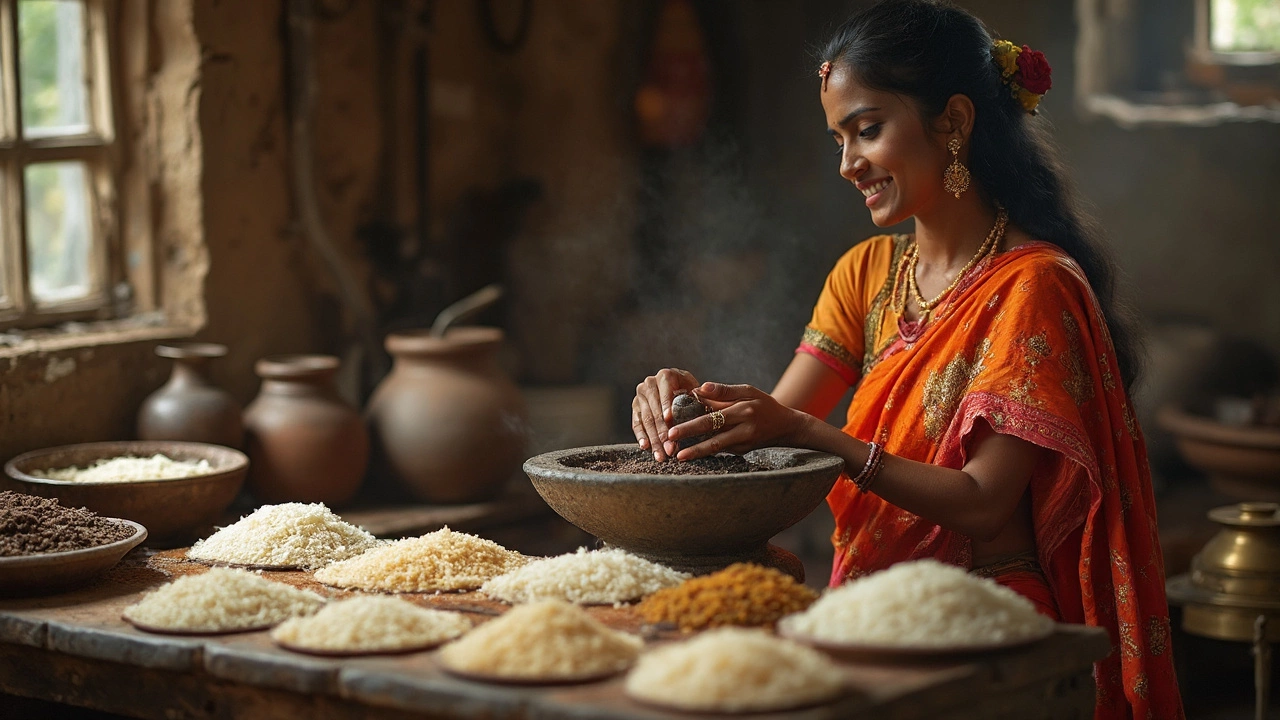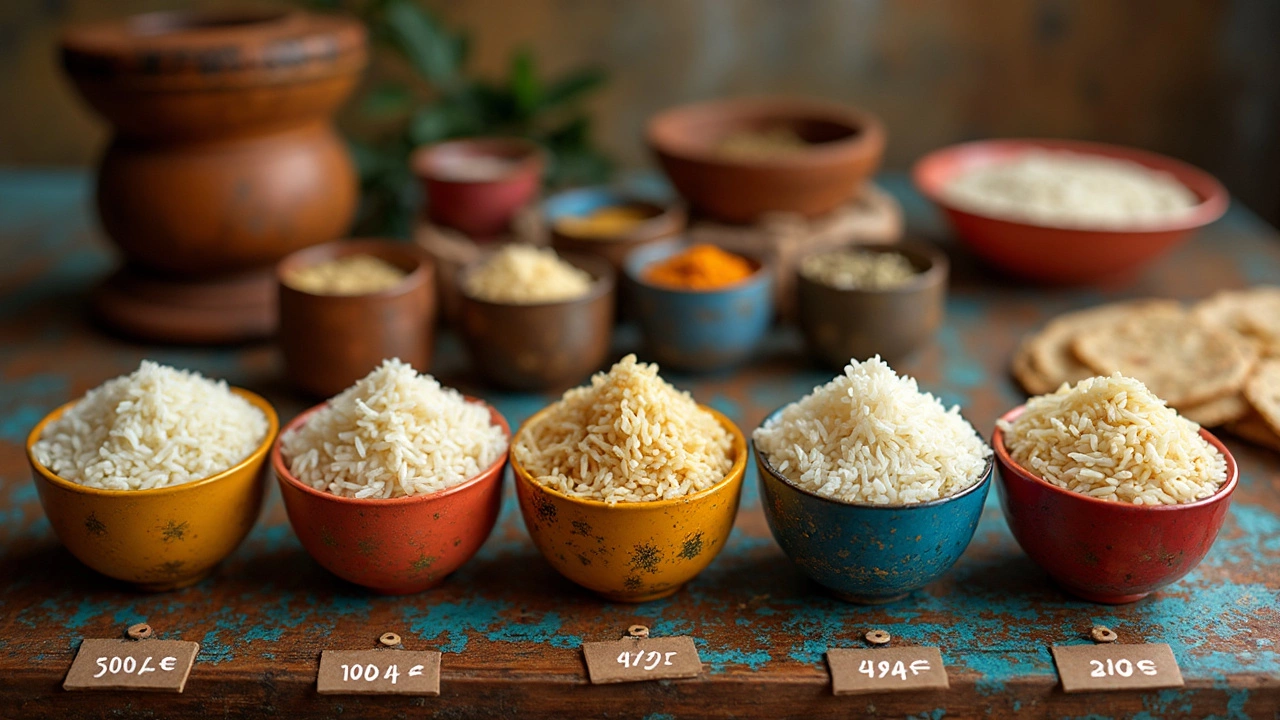When it comes to making dosa, nailing that batter consistency is key. One of the biggest players in achieving this is how long you soak your rice. Too short, and you end up with grainy batter. Too long, and well, things can get mushy. The sweet spot? About 6 to 8 hours. Yep, it’s a bit of a waiting game, but aren’t all good things?
So why does soaking even matter? It softens up the rice, making it easier to blend into a smooth batter. This step is a must if you want your dosas to have that nice, crispy texture. Who doesn’t love that satisfying crackle as you take the first bite?
Keep in mind the type of rice you use can change things a bit. Short-grain rice tends to soak up water faster than its long-grain cousin. So if you swapped your regular rice, give it a few test runs to find the perfect soak time.
- Importance of Soaking Rice
- Optimal Soaking Duration
- Factors Affecting Soaking Time
- Rice-to-Urid Ratio Insights
- Common Mistakes to Avoid
- Pro Tips for Dosa Batter
Importance of Soaking Rice
Alright, let's dig into why soaking rice is a game-changer. Picture this: you want to make dosa, that lovely, crispy Indian pancake. To get that perfect texture, the first step is letting your rice soak. This isn't just some old tradition; it's practical science.
First off, soaking helps break down the grains, making them softer. This makes it a breeze for your blender to whip them into a smooth dosa batter. Remember, a smooth batter is your ticket to perfectly textured dosas. Nobody wants chunks of rice ruining that crunch!
Another reason soaking is crucial is because it activates enzymes in the rice. These enzymes jumpstart the fermentation process, giving your dosa its signature tangy taste. If you've ever wondered why your dosa tasted a little bland, it might be because that rice wasn't soaked long enough.
So, how long should you soak? Generally, a soak of about 6 to 8 hours does the trick. You want the rice plump but not falling apart. Soaking overnight can be a convenient option if you're planning on making breakfast dosas.
Here’s a quick tip: use warm water to speed up the soaking process. Warmer water helps the grains absorb water more efficiently, potentially trimming down your wait time.
Finally, a handy little fact: soaking rice also helps in removing phytic acid. This acid can interfere with mineral absorption, so it's not something you want in large amounts. So soaking isn’t just about that perfect dosa, it’s also about getting a bit of extra nutrition!
Optimal Soaking Duration
The dance of dosa-making often starts with nailing the right soaking time for your dosa batter. It’s all about timing if you want to get it just right. The generally agreed sweet spot sits comfortably between 6 to 8 hours. But why, you ask? Let’s break it down.
When you soak rice, it gradually absorbs water and softens. This sets the stage for it to break down smoothly when you blend it into a batter. Let's say you soak rice for less than six hours; your batter might turn out a bit grainy, leading to dosas that are less than ideal in texture. Extend that soaking beyond eight hours, and you risk the rice becoming overly soft, resulting in a mushy batter.
Of course, conditions can tweak those numbers. If you’re in a warm place, the fermentation process might kick in faster, so 6 hours might be enough. Cool climates might need the full 8 hours or a bit more. It’s a bit like letting time and nature do a slow dance in your kitchen.
There’s another piece to this puzzle: the ratio of rice to urid dal. A typical measure often used is around 3:1, but more on that later. The balance and soaking time can shift the texture and flavor profile of your dosa from crispy heaven to soft bliss.
So, when planning your soaking schedule, aim for that 6 to 8-hour mark as a flexible guideline. Keep your kitchen’s environment in mind, and remember—even if your first few tries aren’t perfect, you'll get it with a bit of practice!
Factors Affecting Soaking Time
Believe it or not, getting the rice soaking time just right for your dosa batter isn’t just about watching the clock. There are several factors at play that you need to keep an eye on.
First off, the type of rice itself. If you're using aged rice, it might need a little extra time soaking because it tends to be drier. On the other hand, fresher rice could get away with a shorter soak.
Now, let’s talk about water temperature. Cooler water means you might need a longer soak, while warm water can speed things up. But don't go reaching for boiling water - that could cook the rice somewhat and ruin your batter.
The ambient temperature where you're soaking your rice matters too. In warmer places, rice might soak faster because of the higher surrounding temperature. In cold climates, you might find that the soaking takes a bit longer.
Here's another twist: the altitude of where you're cooking can make a difference! Higher altitudes might require a bit of a longer soak due to lower barometric pressures.
- Dosa batter doesn't come with a one-size-fits-all rule. Trial and error might just be your best buddy here.
- Keep an eye on how the rice looks and feels. It should be soft to touch but still hold its shape.
- Don’t be afraid to adjust your soaking time based on these factors to achieve that perfect dosa recipe.
In the end, it's all about tuning into these factors and making small tweaks until you find that

Rice-to-Urid Ratio Insights
Getting the rice-to-urid dal ratio right is a big deal when you're whipping up some perfect dosa batter. Think of it as the magic formula behind that wonderful blend of soft insides and crispy edges we all crave.
The common wisdom here is to use a 3:1 ratio of rice to urid dal. Why does this work? Well, the rice gives the dosa that lovely crispiness, while the urid dal contributes to the softness and fermentation that’s crucial for flavor.
Here’s a quick tip though: Your ratio might tweak a bit based on the type of dosa you're aiming for. Some folks, especially if making a lighter or thinner dosa, might opt for a 4:1 ratio to get more crunch.
If you're diving into trying out some alternative grains, like brown rice, your rice-to-urid proportion might need a little adjustment since brown rice alters texture and soak time.
Be sure to rinse both the rice and urid dal well before soaking to get rid of surface starch, which can affect fermentation. And speaking of fermentation, some folks swear by adding a small handful of cooked rice or even a spoonful of fenugreek seeds to the soak, but tread lightly!
| Rice Type | Recommended Ratio | Texture Notes |
|---|---|---|
| Short-Grain | 3:1 | Crispy and light |
| Long-Grain | 4:1 | Extra crispy |
| Brown Rice | 3:1 | Nuttier texture |
So, whether you're sticking to the basic recipe or want to experiment, understanding this balance helps you make the dosa that's just right for you. It's all about tweaking until it fits your flavor expectations. Frankly, that’s the fun part!
Common Mistakes to Avoid
Let’s cut to the chase: making dosa batter isn’t rocket science, but a few common slip-ups can really mess with your results. Here’s what you might be doing wrong.
First off, don’t rush the rice soaking process. If you’re soaking for less than the suggested 6 to 8 hours, you’re probably setting yourself up for a gritty batter. Remember, patience pays off with perfectly crispy dosas.
Another hiccup is using too much water during soaking. Rice should be just submerged — think enough water to cover the rice, plus an inch or so on top. This keeps the rice from becoming waterlogged and mushy, making your batter too runny.
Then there’s the chilling effect of cold water. Using very cold water can stall the soaking, leading to unevenly soaked rice. Stick to room temperature water for more consistent results.
Now, the grind itself can trip you up. Don’t rush it. If you skimp on blending time, you’ll end up with a lumpy mix. Aim for a smooth, slightly runny batter—it should look something like pancake batter.
- Over-fermenting the batter: Fermenting is crucial, but going overboard can make the batter sour. Aim for a fermentation time of 8 to 12 hours in a warm spot.
- Using old rice: Stale rice doesn’t soak well or grind nicely, affecting both texture and taste. Fresh rice means better dosa!
- Ignoring the rice-to-urid ratio: Stick to a 3:1 ratio for most recipes. Adding too much urid can make your dosa soft instead of deliciously crisp.
Being aware of these no-nos can really level up your dosa game. And hey, if you’re like me and learning through the kitchen chaos, remember: even “off” dosas are still pretty darn tasty.
Pro Tips for Dosa Batter
Want to take your dosa game to the next level? Here are some top tips to help you make the best dosa batter:
Dosa batter perfection involves a few tricks beyond just soaking rice. First off, a proper grind is crucial. Many swear by stone grinders for the smoothest batter, but if you're using a regular blender, just make sure it's powerful enough to handle the job without burning out!
- Consistency is key: Aim for something akin to a pancake batter, thick enough to stick to your spoon but not so thick it won't spread. If things are too dry, slowly add water.
- Fermentation matters: Don’t rush it. After mixing, let the batter sit in a warm spot for 8-12 hours. This magic step gives dosa its signature tang and fluffiness.
- Sneak in some methi: A teaspoon of fenugreek seeds can work wonders. It's like a secret ally for better fermentation and contributes to a golden-brown finish.
- Think balance: The classic rice-to-urid dal ratio is 3:1, but don't hesitate to tweak it based on your taste or try different rice types.
- Storage smarts: So you've got extra batter? Keep it in the fridge, but always transfer it to an airtight container so it doesn't capture fridge odors.
Finally, experimenting is how you really get to know your dosa style. Every household has its own twist, some like theirs thinner, others prefer thick and fluffy. The fun part is creating yours.
